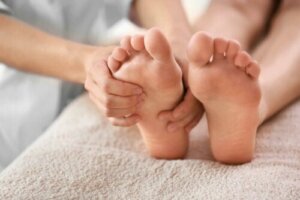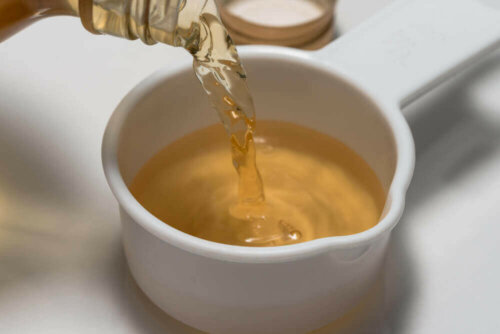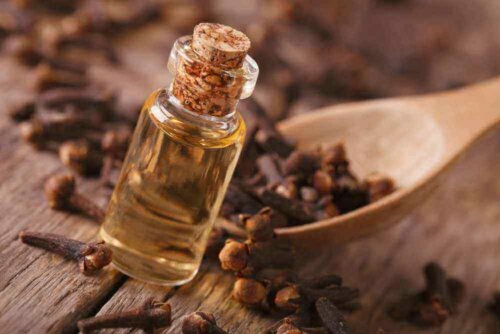How to Relieve Heel Pain with Six Natural Remedies


Reviewed and approved by the doctor José Gerardo Rosciano Paganelli
For adequate management of heel pain, it’s first important to establish its origin. Therefore, first of all, it’s best to consult your doctor and receive a diagnosis.
While over-the-counter pain relievers and anti-inflammatory drugs may be useful, sometimes, other therapeutic measures are necessary. If the pain isn’t due to a serious problem or injury, you can include some natural remedies that provide relief.
Of course, they aren’t a unique solution against pain and should be considered merely a compliment. So, do you want to try them?
What causes heel pain?
Heel pain is a problem that can be caused by multiple factors. It often develops below or behind the heel, but it can also affect one of the sides. If the pain is below the heel, it can be caused by a condition known as plantar fasciitis. If the pain is behind the heel, it could be Achilles tendinopathy. So, how can you relieve this pain?
On the other hand, the heel may be tender, sore or inflamed for a wide variety of causes. Among them are:
- Poor support or cushioning in footwear
- Exercising on hard surfaces
- Excessive activity, especially running
- Jumping and falling with full weight on the heel
- Spurs (osteophytes)
- Bursitis of the heel
- Calcaneal fractures
- Haglund’s syndrome
- Tarsal tunnel syndrome
- Sever’s disease
- Baxter nerve entrapment
- Systemic arthritis
- Bone cysts
- Morton’s neuroma
- Osteomyelitis
- Gout
Natural remedies to treat heel pain
In addition to the use of prescription medications, such as analgesics or anti-inflammatory drugs, and attending therapy, if necessary, there are natural remedies that may be helpful in relieving heel pain. In any case, this should be discussed with your doctor.
Apparently, as exposed by a study, this product has a slight anti-inflammatory effect that could be behind this benefit. However, more studies are needed to confirm it. Anyway, if you want to try it, write down the following recipe.
1. Apple cider vinegar
There’s no evidence linking the external application of apple cider vinegar to the relief of heel pain. However, in the popular literature, it’s said to help relax the foot muscles, especially when used in baths.
It appears, as reported in a study published in the National Libreay of Medicine, that this product has a slight anti-inflammatory effect that could be behind this benefit. However, more studies are needed to confirm this. Anyway, if you want to try it, take note of the following recipe.

Ingredients
- 2 c. of water
- 1/2 c. of apple cider vinegar
Preparation
- First of all, bring the water to a boil
- Then, pour it into a bowl and add the apple cider vinegar
How to use it
- Soak your feet in this liquid for 15 to 20 minutes
- Repeat until you feel an improvement
So, Why Wash Your Face With Apple Cider Vinegar? Know the Benefits
2. Epsom salts
According to Naoki Umeda, a physician at the Cleveland Clinic Center for Integrative Medicine, Epsom salts help relax muscles and are useful for various types of pain. This ingredient, composed of magnesium and salt sulfate, is easily absorbed through the skin and can help reduce swelling.
Ingredients
- 1/2 c. of Epsom salts
- 3 c. of water
Preparation
- First of all, dilute the Epsom salts in hot water
- Then, pour this solution into a large bowl
How to use it
- Finally, soak your heels for 20 minutes and dry carefully
- Use this every day until you feel relief
3. Sage and apple cider vinegar for heel pain
We’ve already commented on the effects attributed to apple cider vinegar against this type of pain. In this case, combine it with sage leaves to obtain a relaxing and anti-inflammatory remedy.
According to a publication in Advanced Herbal Medicine, this treatment takes advantage of the properties of apple cider vinegar with the analgesic and anti-inflammatory action of sage leaves, as they contain a compound called salvigenin. Furthermore, it calms inflammation and improves circulation.
Ingredients
- 6 sage leaves
- 1/2 c. of apple cider vinegar
Preparation
- Crush the sage leaves
- Then, add them to a pot with the apple cider vinegar
- Bring it to a simmer over low heat for five minutes and let it cool to room temperature
How to use it
- Soak a cotton cloth in the liquid
- Then, hold it against the affected area
- Leave this on for two hours before rinsing
- Repeat twice a day, for three or four days
4. Olive oil and clove oil
Clove oil contains an active substance called eugenol which, according to research published in the Revista Brasileira de Farmacognosia, has an analgesic and anti-inflammatory effect. In general, it reduces the intensity of pain.
It’s important to combine it with a carrier oil such as olive oil, as it can be irritating on its own. Let’s look below how to take advantage of these properties if you have heel pain.

Ingredients
- 2 tbsp. of olive oil
- 1 tbsp. of clove essential oil
Preparation
- First, mix the olive oil and clove essential oil
- Then, heat them in the microwave
How to use it
- Make sure the temperature is comfortable for your skin
- Then, rub it in using a gentle massage
- Finally, leave it on without rinsing and repeat twice a day
We think you may also enjoy reading: Five Olive Oil Treatments for Your Skin
5. Petroleum jelly and cayenne pepper
Capsaicin, the active compound of cayenne pepper, acts as an analgesic and anti-inflammatory, favoring pain relief and stiffness.
According to a study published in the British Medical Journal, the topical application of this substance can be a complement to soothe pain in patients who don’t respond to or don’t tolerate other treatments.
Therefore, this ointment with anti-inflammatory properties can serve as a complement to relax your heels in case you suffer a blow or other trauma.
Ingredients
- 3 tbsp. of petroleum jelly
- 1/2 tsp. of cayenne pepper
Preparation
- Soften the petroleum jelly in a water bath
- Then, mix in the cayenne pepper
How to use it
- Once the product has solidified somewhat, take the amount you deem necessary
- Then, apply it to your heel using a gentle massage
- Repeat this twice a day
6. Arnica tincture for heel pain
The evidence on the effects of arnica against pain is still under investigation. In general, arnica tincture has a calming effect and controls the pain caused by blows.
A study published in the European Journal of Sport Science reports that its topical application may contribute to pain relief three days after eccentric exercise. However, more evidence is needed.
Ingredients
- 1/2 tsp. of arnica tincture
- 2 tbsp. of olive oil
Preparation
- Combine the arnica with the olive oil
How to use it
- Firstly, massage this product into your heel
- Leave it on without rinsing
- Finally, use twice a day if your pain persists
Other things you can do to relieve heel pain
In addition to the natural remedies mentioned above, other care and measures may be required to prevent or relieve heel pain:
- Rest
- Use crutches when walking certain distances
- Apply local ice
- Use heel pads
- Wear shoes with good support
- Exercise on soft surfaces
When you should see a doctor
Have you suffered from an injury to your heels? Did your shoes leave your feet feeling sore and tired? If so, try any of the treatments in this article, as you may find some relief. If your pain is severe or persistent, consult your doctor at once.
All cited sources were thoroughly reviewed by our team to ensure their quality, reliability, currency, and validity. The bibliography of this article was considered reliable and of academic or scientific accuracy.
- Moallem, S., Barahoyee, A. (2010). Evaluation of acute and chronic anti-nociceptive and anti-Inflammatory effects of apple cider vinegar. Iranian Journal of Pharmaceutical Research, Volume 3(Supplement 2), 57-57. doi: 10.22037/ijpr.2010.466
- Anand, P., & Bley, K. (2011). Topical capsaicin for pain management: Therapeutic potential and mechanisms of action of the new high-concentration capsaicin 8 patch. British Journal of Anaesthesia. https://doi.org/10.1093/bja/aer260
- Mansourabadi, Amir Hossein & Sadeghi, H.M. & Razavi, N. & Rezvani, E.. (2015). Anti-inflammatory and Analgesic Properties of Salvigenin, Salvia officinalis Flavonoid Extracted. Advanced Herbal Medicine. 1. 31-41.
- Chaieb, K., Hajlaoui, H., Zmantar, T., Kahla-Nakbi, A. Ben, Rouabhia, M., Mahdouani, K., & Bakhrouf, A. (2007). The chemical composition and biological activity of clove essential oil, Eugenia caryophyllata (Syzigium aromaticum L. Myrtaceae): A short review. Phytotherapy Research. https://doi.org/10.1002/ptr.2124
- Daniel, A. N., Sartoretto, S. M., Schmidt, G., Caparroz-Assef, S. M., Bersani-Amado, C. A., & Cuman, R. K. N. (2009). Anti-inflammatory and antinociceptive activities of eugenol essential oil in experimental animal models. Brazilian Journal of Pharmacognosy, 19(1 B), 212–217. https://doi.org/10.1590/S0102-695X2009000200006
- Gali-Muhtasib, H., Hilan, C., & Khater, C. (2000). Traditional uses of Salvia libanotica (East Mediterranean sage) and the effects of its essential oils. Journal of Ethnopharmacology. https://doi.org/10.1016/S0378-8741(99)00190-7
- Mason L, Moore RA, Derry S, Edwards JE, McQuay HJ. Systematic review of topical capsaicin for the treatment of chronic pain. BMJ. 2004;328(7446):991. doi:10.1136/bmj.38042.506748.EE
- Pumpa, K. L., Fallon, K. E., Bensoussan, A., & Papalia, S. (2014). The effects of topical Arnica on performance, pain and muscle damage after intense eccentric exercise. European Journal of Sport Science. https://doi.org/10.1080/17461391.2013.829126
- Waring, R. (2010). Report on Absorption of magnesium sulfate (Epsom salts) across the skin. Analysis. https://doi.org/accessed on 30 August 2012.
- Tsoupras, A., Et al. (2021). Anti-Inflammatory and Anti-Platelet Properties of Lipid Bioactives from Apple Cider By-Products. Molecules. 26(10): 2869. https://www.ncbi.nlm.nih.gov/pmc/articles/PMC8150973/
This text is provided for informational purposes only and does not replace consultation with a professional. If in doubt, consult your specialist.








